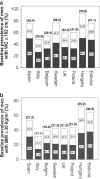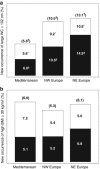Changes in prevalence of obesity and high waist circumference over four years across European regions: the European male ageing study (EMAS)
- PMID: 27734258
- PMCID: PMC5272876
- DOI: 10.1007/s12020-016-1135-y
Changes in prevalence of obesity and high waist circumference over four years across European regions: the European male ageing study (EMAS)
Abstract
Diversity in lifestyles and socioeconomic status among European populations, and recent socio-political and economic changes in transitional countries, may affect changes in adiposity. We aimed to determine whether change in the prevalence of obesity varies between the socio-politically transitional North-East European (Łódź, Poland; Szeged, Hungary; Tartu, Estonia), and the non-transitional Mediterranean (Santiago de Compostela, Spain; Florence, Italy) and North-West European (Leuven, Belgium; Malmö, Sweden; Manchester, UK) cities. This prospective observational cohort survey was performed between 2003 and 2005 at baseline and followed up between 2008 and 2010 of 3369 community-dwelling men aged 40-79 years. Main outcome measures in the present paper included waist circumference, body mass index and mid-upper arm muscle area. Baseline prevalence of waist circumference ≥ 102 cm and body mass index ≥ 30 kg/m2, respectively, were 39.0, 29.5 % in North-East European cities, 32.4, 21.9 % in Mediterranean cities, and 30.0, 20.1 % in North-West European cities. After median 4.3 years, men living in cities from transitional countries had mean gains in waist circumference (1.1 cm) and body mass index (0.2 kg/m2), which were greater than men in cities from non-transitional countries (P = 0.005). North-East European cities had greater gains in waist circumference (1.5 cm) than in Mediterranean cities (P < 0.001). Over 4.3 years, the prevalence of waist circumference ≥ 102 cm had increased by 13.1 % in North-East European cities, 5.8 % in the Mediterranean cities, 10.0 % in North-West European cities. Odds ratios (95 % confidence intervals), adjusted for lifestyle factors, for developing waist circumference ≥ 102 cm, compared with men from Mediterranean cities, were 2.3 (1.5-3.5) in North-East European cities and 1.6 (1.1-2.4) in North-West European cities, and 1.6 (1.2-2.1) in men living in cities from transitional, compared with cities from non-transitional countries. These regional differences in increased prevalence of waist circumference ≥ 102 cm were more pronounced in men aged 60-79 years than in those aged 40-59 years. Overall there was an increase in the prevalence of obesity (body mass index ≥ 30 kg/m2) over 4.3 years (between 5.3 and 6.1 %) with no significant regional differences at any age. Mid-upper arm muscle area declined during follow-up with the greatest decline among men from North-East European cities. In conclusion, increasing waist circumference is dissociated from change in body mass index and most rapid among men living in cities from transitional North-East European countries, presumably driven by economic and socio-political changes. Information on women would also be of value and it would be of interest to relate the changes in adiposity to dietary and other behavioural habits.
Keywords: Body mass index; Environment; Fat distribution; Health promotion; Obesity; Waist circumference.
Conflict of interest statement
FCWW has acted as a consultant for Bayer-Schering, Eli Lilly and Besins Healthcare and also participated in advisory board meetings and lectured on their behalf. FCWW has received lecture fees from Bayer-Schering and Besins Healthcare. FCWW has received grant support (2010-2014) from Bayer Schering AG and Besins Healthcare. ITH is a consultant and/or has received grants from Ferring Pharmaceuticals, Takeda and Novartis. MEJL has received departmental research funding from, and served on advisory boards for, Novo Nordisk, Orexigen. All other authors have nothing to disclose. Ethical approval Ethical approval for the study was obtained in accordance with the ethical standards of the institutional and national research committee and with the 1964 Helsinki declaration and its later amendments or comparable ethical standards. Informed consent Informed consent was obtained from all individual participants included in the study.
Figures
References
-
- National Cholesterol Education Program (NCEP) Expert Panel on Detection, Evaluation, and Treatment of High Blood Cholesterol in Adults (Adult Treatment Panel III), Third Report of the National Cholesterol Education Program (NCEP) Expert Panel on Detection Evaluation, and treatment of high blood cholesterol in adults (Adult Treatment Panel III) final report. Circulation. 2002;106:3143–3421. - PubMed
MeSH terms
LinkOut - more resources
Full Text Sources
Other Literature Sources
Medical



